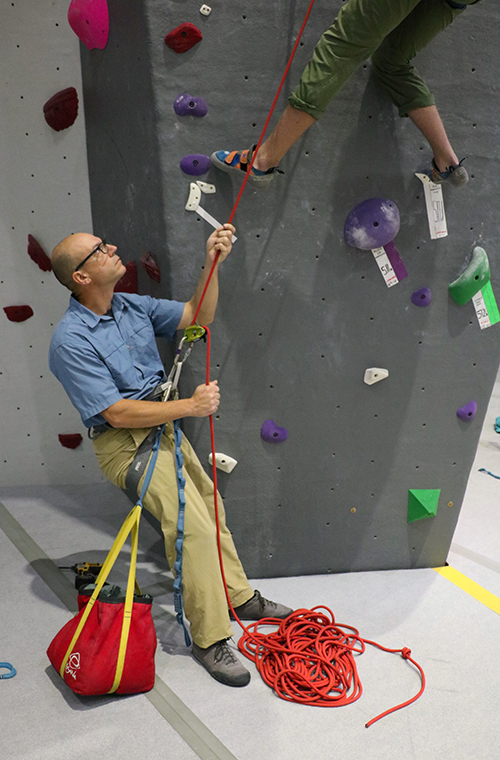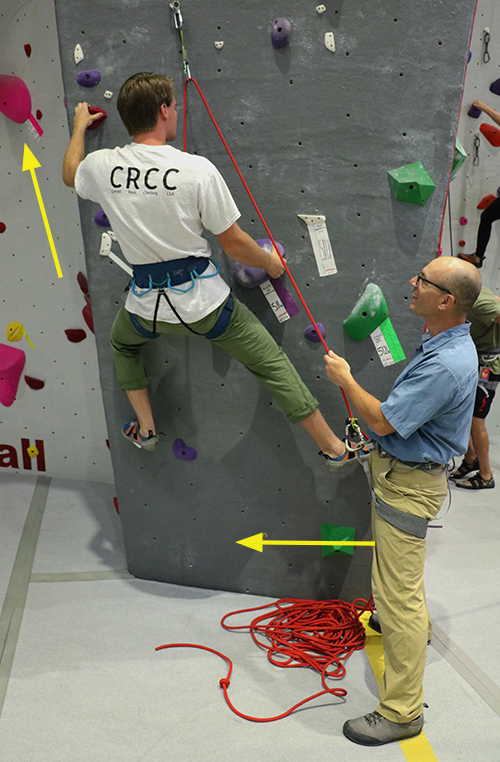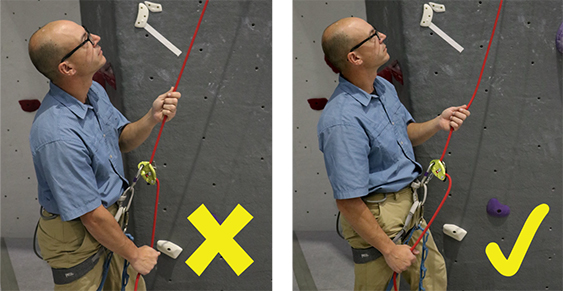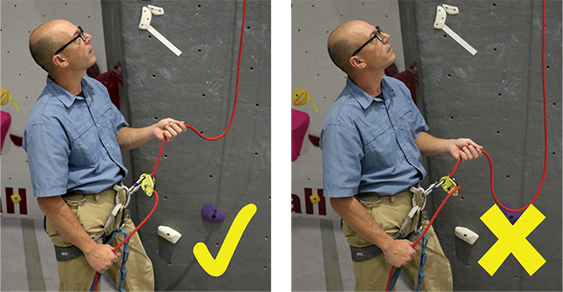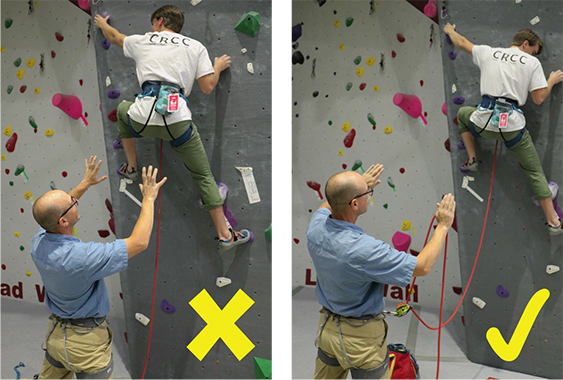Slack Management and Catching Falls
Setting Up the Belay
As we mentioned, the belayer's supportive role begins on the ground - flaking the rope in an appropriate place, being mindful of other climbing parties who may intersect with the chosen route, and doing a thorough partner check. The belayer should also consider whether a mobile anchor, or Ohm is appropriate, to prevent being pulled too high off the ground in the event of a fall. Once you are On Belay, a good belayer watches and anticipates the climber’s needs, giving rope at the right time, taking in rope when needed, prepping for a fall, alerting their climber to potential hazards, and coaching them through problems. There are many distractions at the gym, learn to ignore them while belaying.
Belay Device Proficiency
Assisted braking devices are required for lead belaying. Belayers are expected to use their device according to the manufacturer’s specifications. Check with front desk staff if you are unsure about your device of choice. Prior proficiency with an appropriate belay device is essential. Belayer should be able to switch between giving and taking rope comfortably, without “short-roping” the climber. Belay methods that inhibit the device’s ability to assist in the braking of the rope are unacceptable, such as holding the GriGri cam down continuously, or keeping a tube style device in the unlocked position.
Mobile Anchor
In the event of a fall, the belayer should maintain control of their body so that they do not risk compromising the catch or impacting the falling climber. If your climber outweighs the belayer significantly, consider using a mobile anchor, which connects to your belay loop below the belay device and helps keep the belayer from being pulled up the wall. Position the anchor slightly behind you and the stack, on the same side as the brake hand. This position will protect your brake hand from impacting the wall. Never use the fixed ground anchors for lead belaying at Lindseth.
Belaying, a.k.a Slack Management
Throughout the climb, the belayer’s goal should be to give the climber enough rope for efficient movement and clipping, and, when catching falls, reducing the climber’s risk of impacting the ground, wall features, or other people. The appropriate amount of slack in the system changes over the course of the climb. The belayer can and should move their position to micromanage the amount of slack - this is a “dynamic” belay - though they should remain within 2-3 steps of the first bolt. If the belayer steps back for a “take,” they should always move back under the clip when the climber continues or lowers.
Belay Position
To avoid the risk of the climber falling onto the belayer, the belayer should locate themselves below and to the side of the first clip, opposite to the direction of the climb. After the climber is above the 3rd or 4th clip, they should move directly under the first clip. In the event of a fall, they will get pulled upward and stay in control, rather than getting pulled toward the wall, risking injury and loss of control. Even if the climber is out of sight, the belayer should remain properly positioned.
How Much Slack is Appropriate?
A tighter belay is appropriate for the first 3-4 clips, because of the risk of groundfall, and the belayer should initially help keep the rope between the climber and wall. However, there needs to be enough slack for the climber to make progress. A looser belay is appropriate higher off the ground, where a soft catch is preferred. Excess slack increases the distance of a fall and the time required to initiate a catch. Not enough slack can impede to climber’s movement or ability to clip. When this happens it is called "short-roping" the climber, and could contribute to a climber's unanticipated fall. The rope should never drape below the belay device.
Catching Falls
Spotting
Spotting is not required at the Lindseth Climbing Center. The spotter’s goal is to protect a climber’s head and neck from impact with the floor. The practice is optional, but if done must be done safely. Spotter should stand 2-3 steps behind the climber, with palms out and thumbs in (spoons not forks), ready to keep a climber from falling onto their back and head. Spotter must be able to transition to belay, with the appropriate amount of slack, before the first clip is completed.
When catching falls, the belayer must maintain a hand on the brake strand, and give a catch that is appropriate to the climber’s position on the wall. During a fall, the climber’s safety (hitting the ground, features, or other people) as well as the belayer’s (hitting the wall or holds with head, body or feet, or getting pulled up into the climber) are at risk. For the first few clips, a harder catch is required to reduce the risk of groundfall. Above the 3rd or 4th clip, a soft catch is necessary to reduce the forces acting on the climber’s body after a fall. For a soft catch, belay with the appropriate amount of slack, then let the rope pull you up when it comes tight; most belayers should not need to actively jump.
After a fall, check in with the climber, regain a proper belay stance on the ground, then continue the belay as usual. An additional command from the climber "ON ME" can signal when the climber has transferred from hanging on the rope to a controlled stance and is ready to continue leading. At that point the belayer should be prepared to give out the appropriate amount of slack, and continue the belay.
Resetting
When the climber is on the ground and Off Belay, be sure to untie all knots, pull the rope backwards through the draws, not out in space, and re-flake the rope in the appropriate location for the next climb. Consider flipping the rope at least once during your session to reduce wear on specific areas. Check in with each other and discuss opportunities for improvement to strengthen the partnership.

